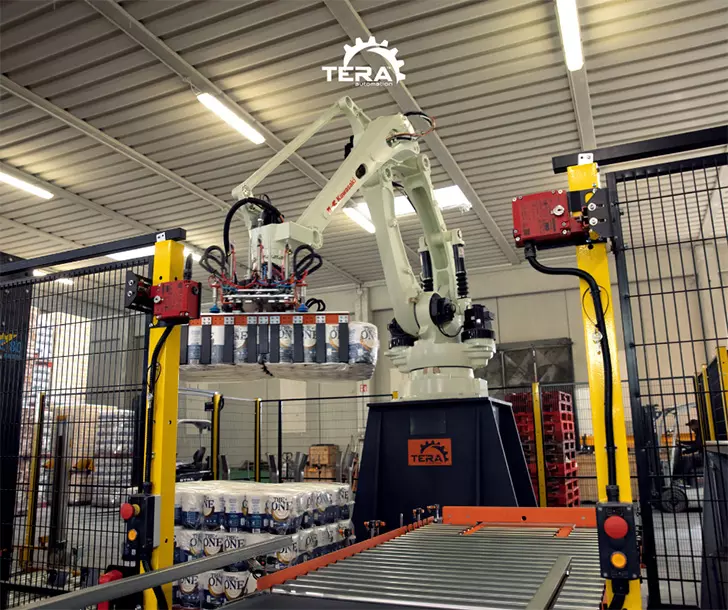
An automated industrial line that optimizes production
It was 1959 when industry and civilization saw for the first time a robot replace man in the strenuous tasks of the General Motors assembly line. That day marked the incipit of an increasingly automated and optimized production in which robots became protagonists.
For us at Tera Automation, the approach to robotics was also a natural and necessary response to the improvement of automated solutions for the production of precious metal ingots.
The subsequent acquisition of expertise in the world of robots allowed us to broaden our gaze towards new areas where our automation know-how could be an asset. Palletizing is one of these areas.
Automation and logistics
One of the sectors relying most heavily on automation is logistics, which nowadays must adapt to constant fluctuations in the market and work volumes.
The increasing demand for efficiency and precision in this sector has pushed companies to look for innovative solutions for palletizing goods, a crucial step within a warehouse or distribution centre.
In this context, robots have revolutionized the modus operandi, allowing a significant improvement in speed, precision and safety.
Advanced solutions for industrial automation
Robotic islands for palletizing are advanced industrial automation systems designed to efficiently and accurately handle and organize loads on pallets.
To create a highly automated working environment, these solutions combine the use of:
- industrial robots
- transport systems
- machine vision devices
- control software
Palletizing islands offer numerous advantages to companies. First and foremost, they improve efficiency and productivity, since they reduce dependence on manual labour and enable continuous, uninterrupted operation.
Furthemore, the use of robots and automated systems reduces human error and ensures greater precision in the handling of loads. This translates into greater repeatability and quality of the final product.
Flexibility
Flexibility and adaptation are the keywords driving the logistics sector, which is increasingly exposed to the unpredictability of the market.
Robotic islands and Artificial Intelligence are the most performing answer to this great modern challenge, here is how:
| problem | solution |
|
need to respond quickly to market and demand fluctuations |
flexibility in changing the format of handled elements and volume management |
|
need to respond quickly to production changes and sudden breakdowns |
flexibility in plant reconversion and robot reprogramming |
A matter of grip
As if they were real limbs, grippers determine a large part of a robot’s abilities. Just think of the introduction of electropneumatic grippers to replace traditional pneumatic grippers.
Thanks to the combined use of electric and pneumatic actuators, these grippers offer superior accuracy and flexibility in lifting and handling loads.
They can easily adapt to different sizes and shapes of loads, allowing for quick and easy format changes. The ability to manage both grip force and grip width allows product handling without any risk of damage, just like hands.
Cutting-edge materials
Innovations are also growing in the field of materials applied to robots. The use of carbon fiber for blades offers a unique combination of mechanical strength and structural rigidity.
By using this material, we were able to reduce the overall weight of the gripper, thereby improving the energy efficiency of the robots and increasing the overall load capacity of the palletizing island. Another advantage in terms of productivity.
Transport systems
Another important feature of robot palletizing islands is the use of transport systems. These systems enable the movement of pallets within the working area of the robotic island.
They may consist of conveyor belts, rotary tables, or other devices which facilitate the smooth transfer of pallets between different work stations within the island. Again, good integration of transport systems ensures efficient handling of loads and optimized workflow.
In practice, you can entrust the handling of goods to mobile robots, which move between the aisles of your warehouse in total autonomy.
Vision devices
Machine vision devices are in fact the eyes of robotic palletizing islands. These devices, such as cameras and sensors, enable the system to recognize and detect objects, their position and orientation.
This information is crucial to ensure that robots position loads precisely and accurately on pallets. Thanks to machine vision, errors can be reduced and the quality and reliability of the palletizing process can be improved.
Artificial Intelligence: learning, correcting and coordinating
Robotic palletizing islands have reached new levels of efficiency thanks to the integration of Artificial intelligence (AI). This advanced technology allows systems to learn and adapt in real time, optimizing the palletizing process.
The robots are therefore able to acquire data on specific parameters, such as operating time, weight and size of loads. Furthermore, through dialogue between robots and vision systems, Artificial Intelligence is able to automatically detect errors during the palletizing process and correct them accordingly.
Coordinating with JARVIS
Finally, these solutions can be integrated with enterprise resource planning (ERP) systems and operation monitoring and control software. This enables more efficient management and better traceability of materials and products within the palletizing process.
Imagine a constantly updated network in which robots, vision systems, production, management and warehouse systems exchange data under the supervision of an Artificial Intelligence geared towards process optimization and error reduction. With this in mind, the boundary between logistics and true automation almost seems to disappear!
T-Flexipack™, maximimum flexibility and efficiency
Our T-Flexipack™ palletizing island is a state-of-the-art solution that meets all the production and automation needs of modern industry. Companies are increasingly oriented towards just-in-time production, with small batches and exclusive products. In this context, flexibility, product tracking and speed of adaptation are key priorities.
T-Flexipack™ meets all these needs, offering a highly flexible system that can track and manage all the products efficiently and adapt quickly to every situation.
Thanks to T-Flexipack™, companies can improve efficiency, accuracy and safety in industrial logistics, while keeping up with market challenges and evolutions.
